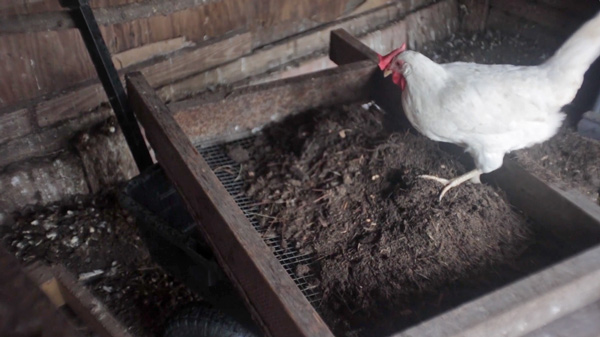Start Composting Now!
Here are six easy unconventional methods to get you started.
1. Continuous piles
Get yourself a bin or a few pallets, then start throwing in your house and garden waste, fall leaves, coffee grounds from a local espresso joint and whatever you can find. Or just pile it on the ground. Don’t worry too much about your “greens” and “browns,” just pile it up and let nature break it down. THROW IT ON THE GROUND! That’s what nature does! In a few months, you can dig into the pile and start harvesting homegrown humus.
PRO-TIP: Water your pile really well as you add layers – without enough moisture, it takes much longer for materials to break down.
2. Melon pits
Dig a 2-3′ deep pit and throw in nasty nitrogenous materials, then plant on top. You can put in a few cups of raw chicken manure or a dead chicken or a lasagna or even a spoiled pork chop. The plants you grow on top will find that material as it breaks down and will run like crazy! This is particularly useful for growing running vines like pumpkins or melons.
(Just be careful with the pork chops – or else – terror!)
3. Swamp water
This is one of my favorite methods. In fact, I posted on it just recently.
Basically, you put a bunch of weeds, grass and other materials in a barrel of water and let it rot down for a few weeks or months, then use the diluted liquid to feed your gardens. Just this method from Compost Everything could be a book of its own – it works great! You can stretch a small amount of materials over a large garden space with very little work and grow fine crops.
4. Grow your own compost
Cover crops can transform the soil. You can also grow lots of chop-and-drop plants in your food forest projects and orchards, deliberately mulching with them to slowly release nutrients as they turn into humus.
5. Reinvigorate a single garden bed by turning it into a compost pile
If you have raised beds in your garden, why not turn one of them into a compost pile for a while? It makes a huge difference in the soil beneath. Compost on a bed for a while, then scrape off the top layer and put it on another bed when you’re ready to plant. This improves the soil beneath the pile and leaves lots of humus behind.
6. Use chickens to compost everything
If you keep chickens, why not use them to compost and skip the bin altogether, like this? If you have an enclosed chicken run, you can simply throw scraps and weeds in it and let them chew and shred and manure it until you have lots and lots of rich compost for the garden. We get wheelbarrows of compost from the chicken run!
You’ll find much more on composting in my popular index-free book Compost Everything: The Good Guide to Extreme Composting.
It’s been quite popular since its release, as it simplifies and streamlines compost making so everyone can do it.
But if you already have Compost Everything and want to go deeper in your composting knowledge, I think you’ll really enjoy Steve Solomon’s new release Easy Composting for Organic Gardeners!
Description:
“Easy Composting for Organic Gardeners helps you get the humus you need to transform your soil and your crops. Don’t worry about fertilizer shortages or supply line disruptions – let Steve Solomon show you how to compost in this re-release of his classic book, now with a new introduction by David The Good.
This book is the perfect addition to any prepper or survival gardening library, as well as a valuable resource for anyone interested organic gardening.
Start making compost today – let Steve Solomon show you how.”
Finally, I recently got back from joining Doug and Stacey at the Homesteading Life Conference in Hannibal, Missouri. It was a great event with a lot of wonderful people, including Billy and William from Perma Pastures Farm, and my new friends from The Healing Homestead, who told me they saved their garden with swamp water this year! How cool.
I’ll be filming more videos this week on the new homestead. Stay tuned – and until next time, may your thumbs always be green.
-David The Good




4 comments
David,
Do you let your chicken run compost age before applying to your beds? I’ve got a big run that’s been braking down into good dirt, and was curious if I could just add 1 inch of the chickie dirt to each of my garden beds and then direct seed into it, or if I would need to let it age for a while?
Thanks,
Joshua
I don’t let it age – I just plant right in it. A half-inch is probably enough.
We got our first compost pile going this weekend, using “mowed down” wood chips from a chip drop and grass from our mowing our yard. Reading Compost Everything: The Good Guide to Extreme Composting was a huge spur for us to just get it done and stop worrying about everything being perfect.
That left me thinking that with a few pallets we could get a really nice four pile system going… but first, we have to pick up more cardboard to help suppress the dreaded bermuda grass in the garden area.
Love me some fetid swamp water. Zone 6 We have previously always composted our winter chicken tractor bedding. We leave them in place over the winter. Then in march start top dressing garden beds. We now have an unlimited supply of hardwood shavings. So I’m adding shavings a lot more frequently to the stationary chicken housing. If we can rake this out monthly. Thats a lot of side dressing!
Comments are closed.